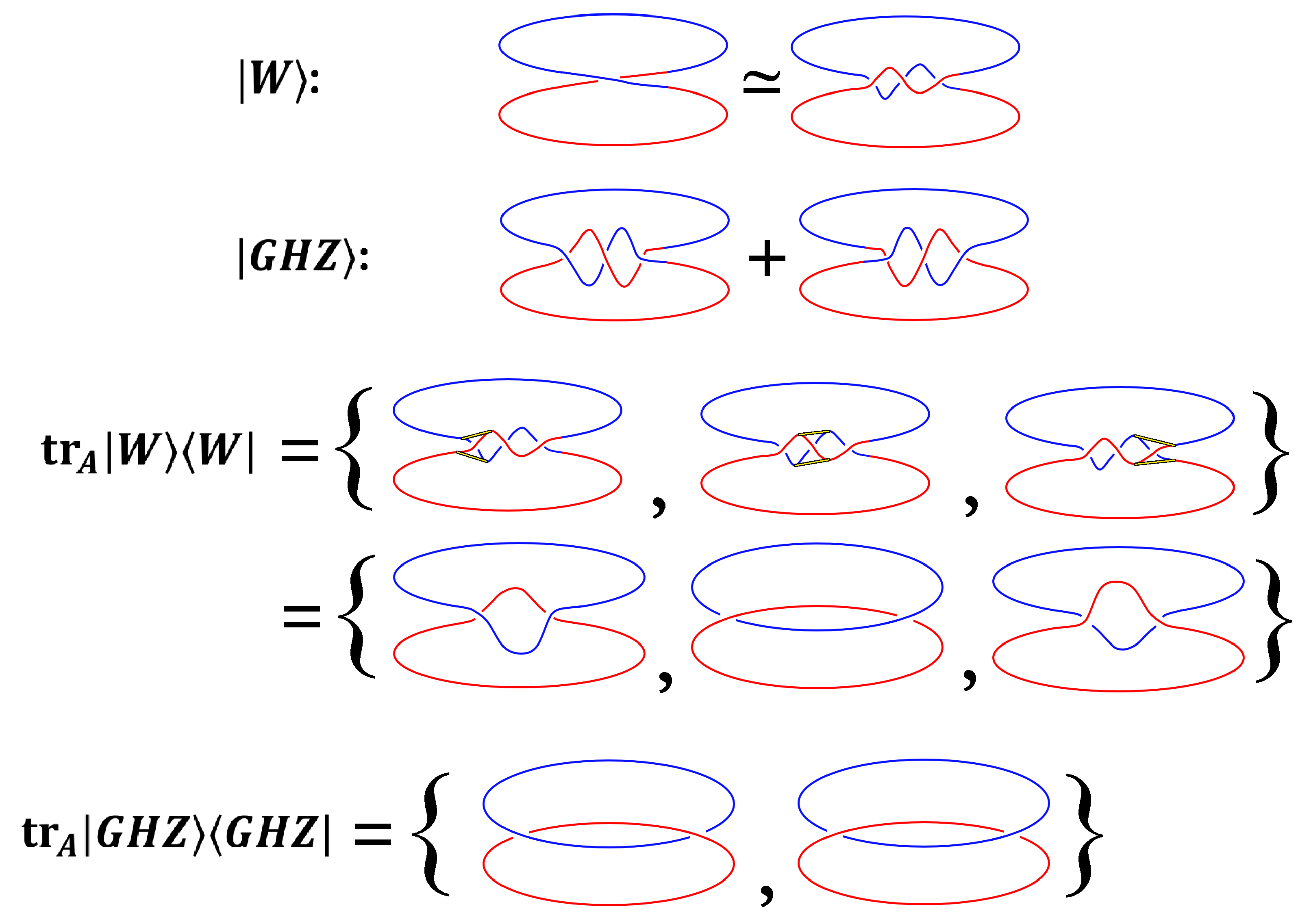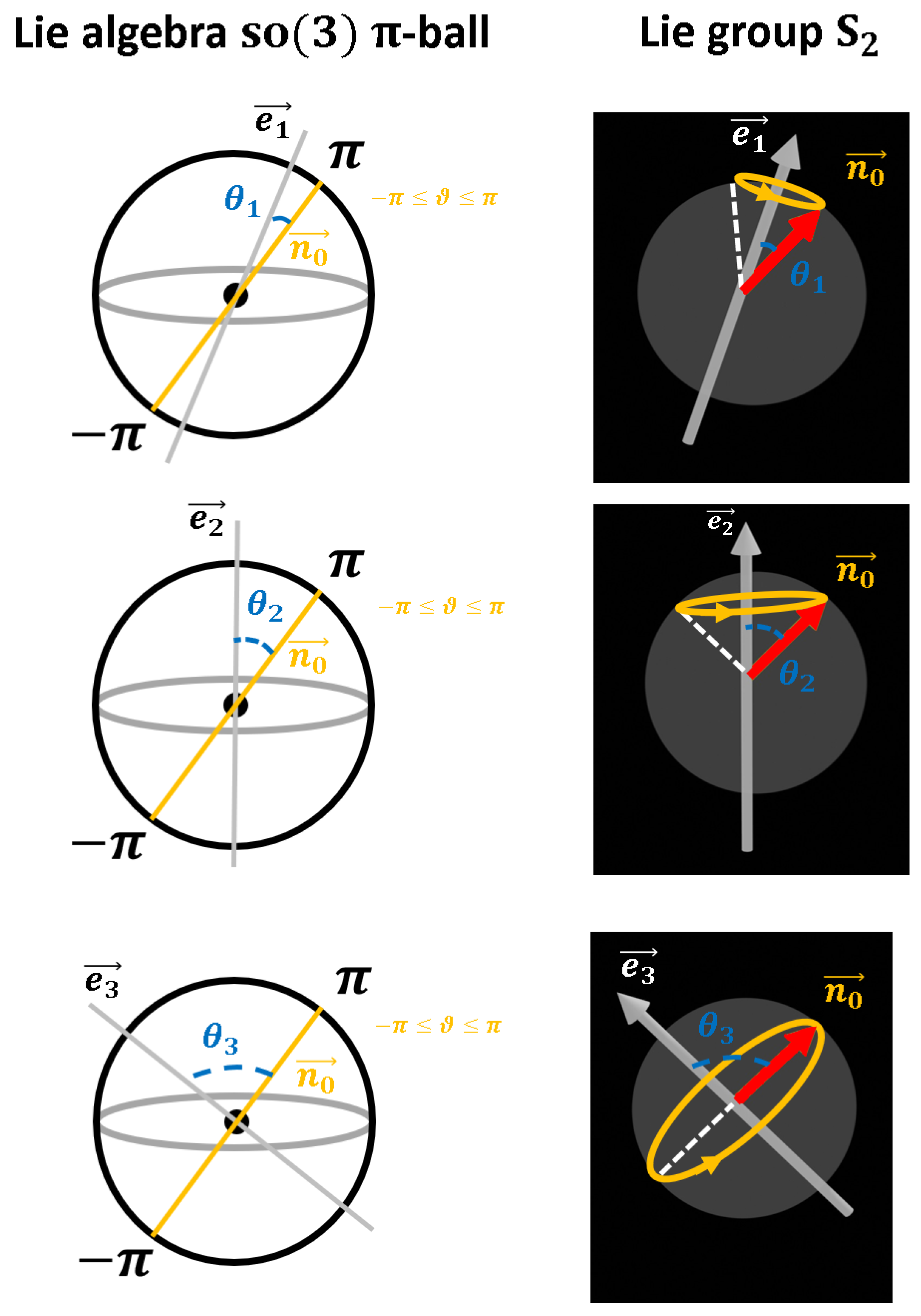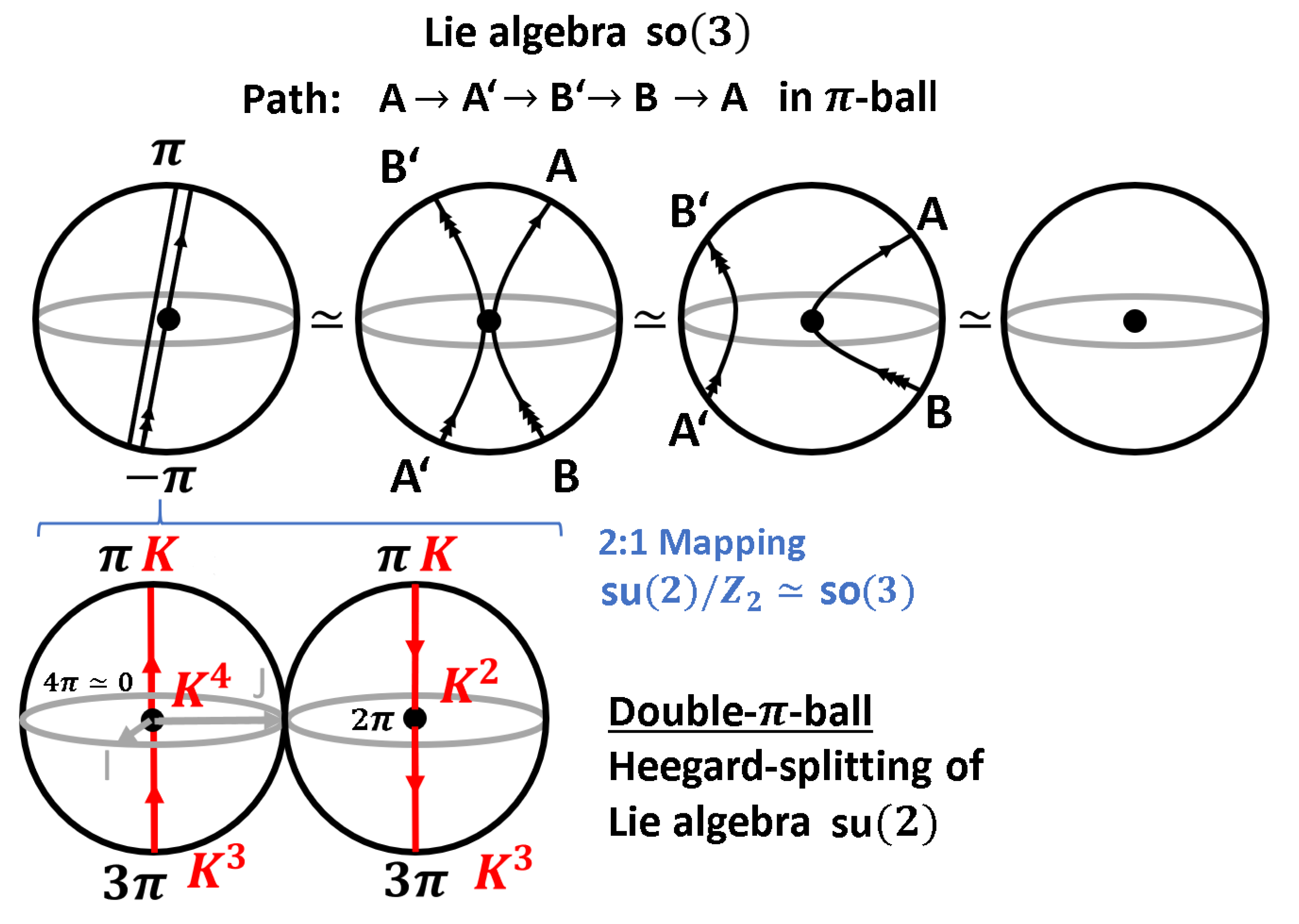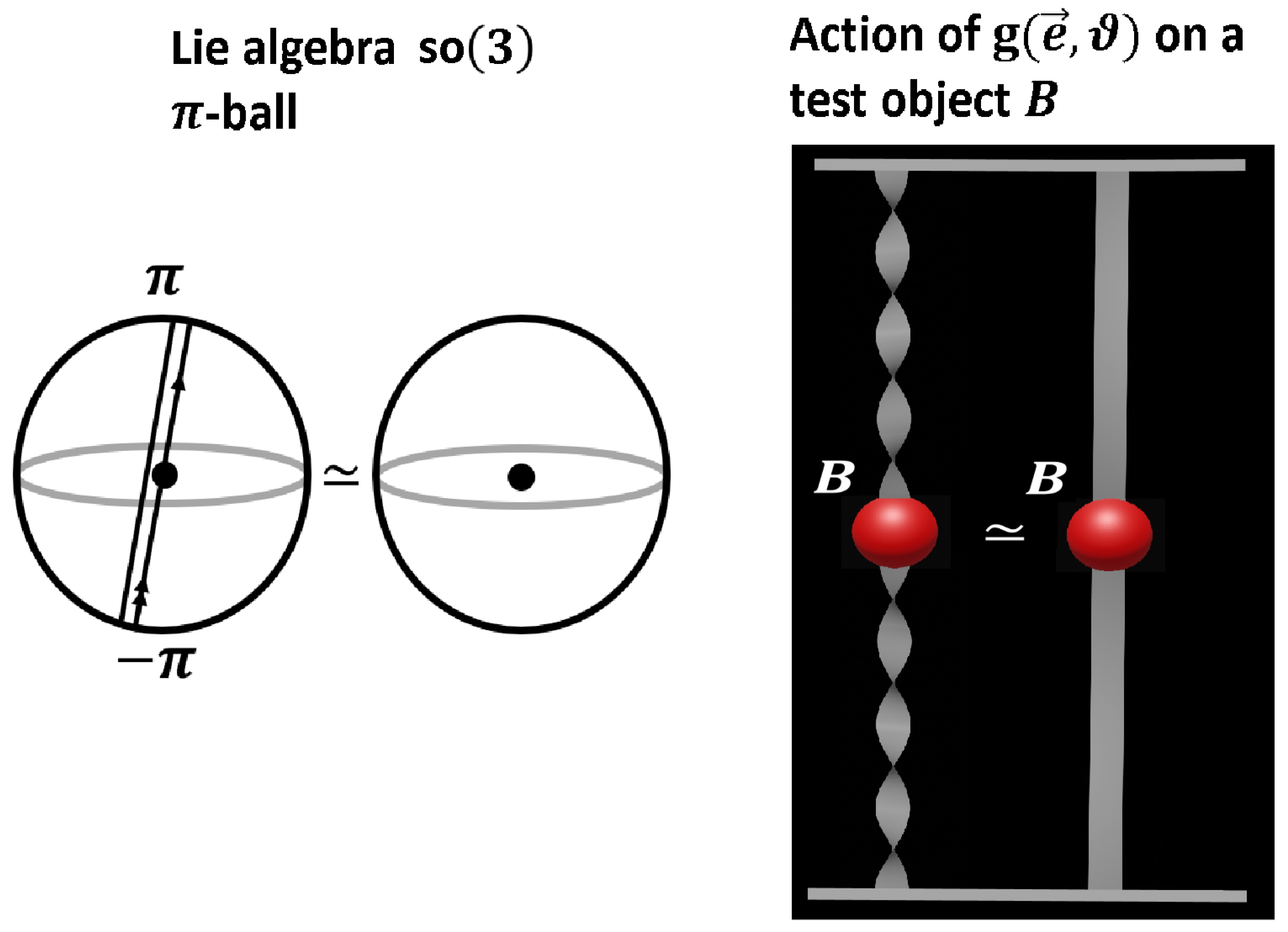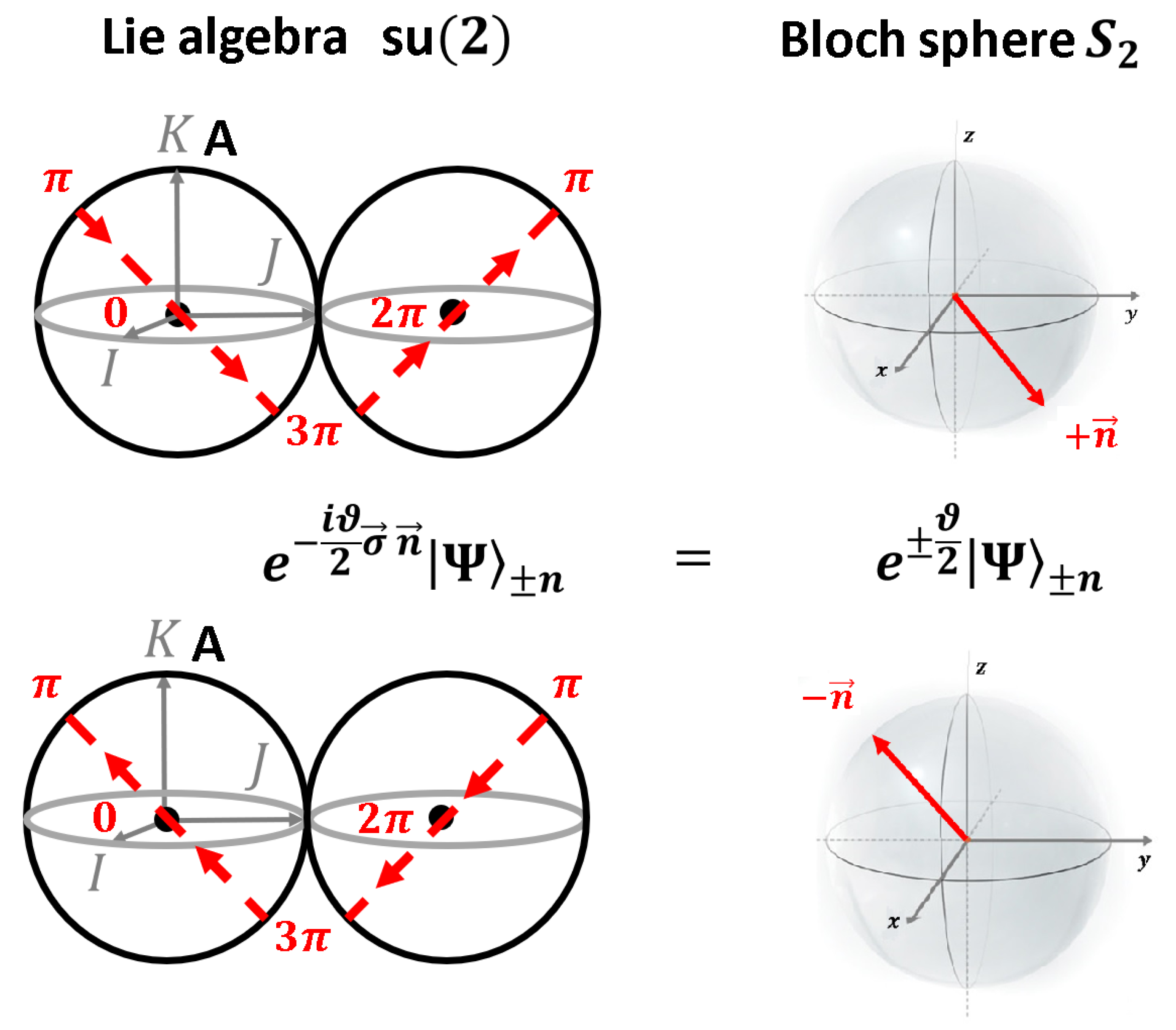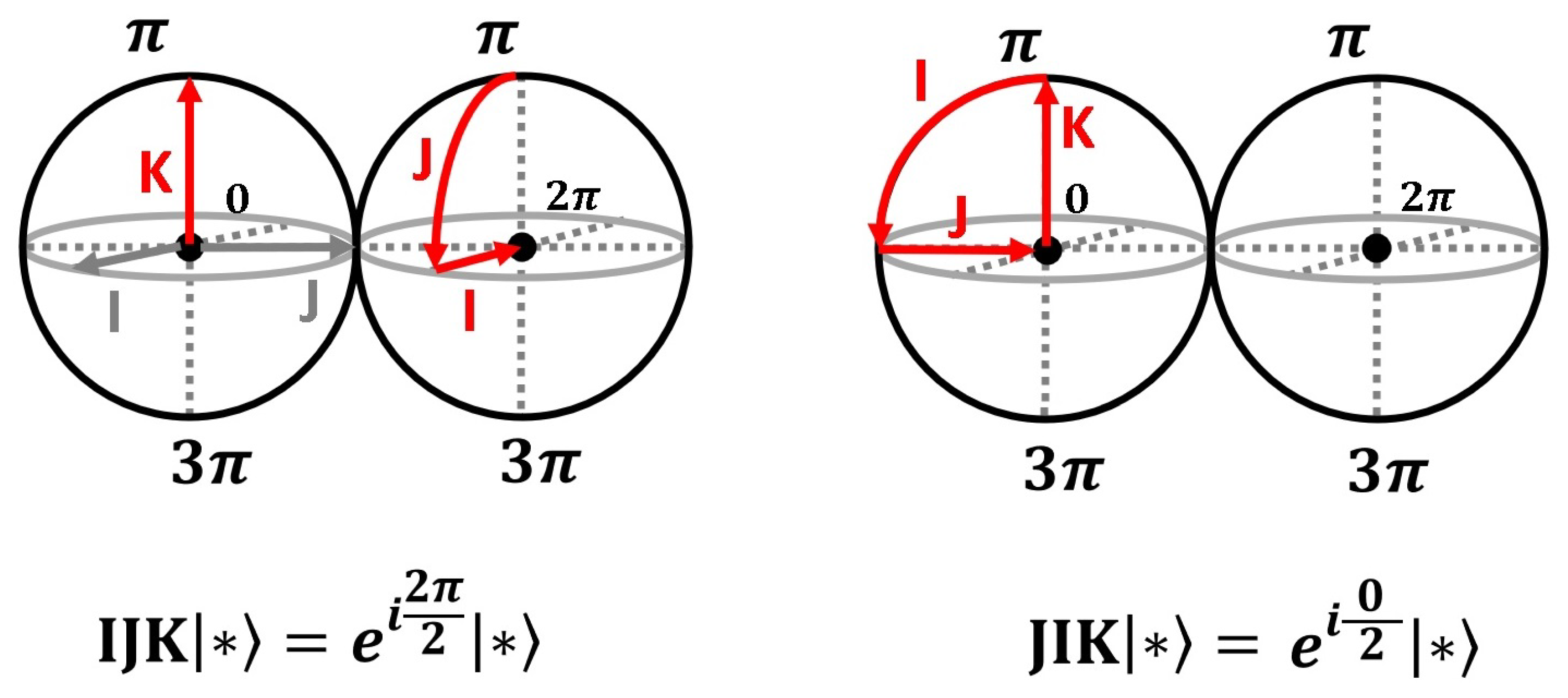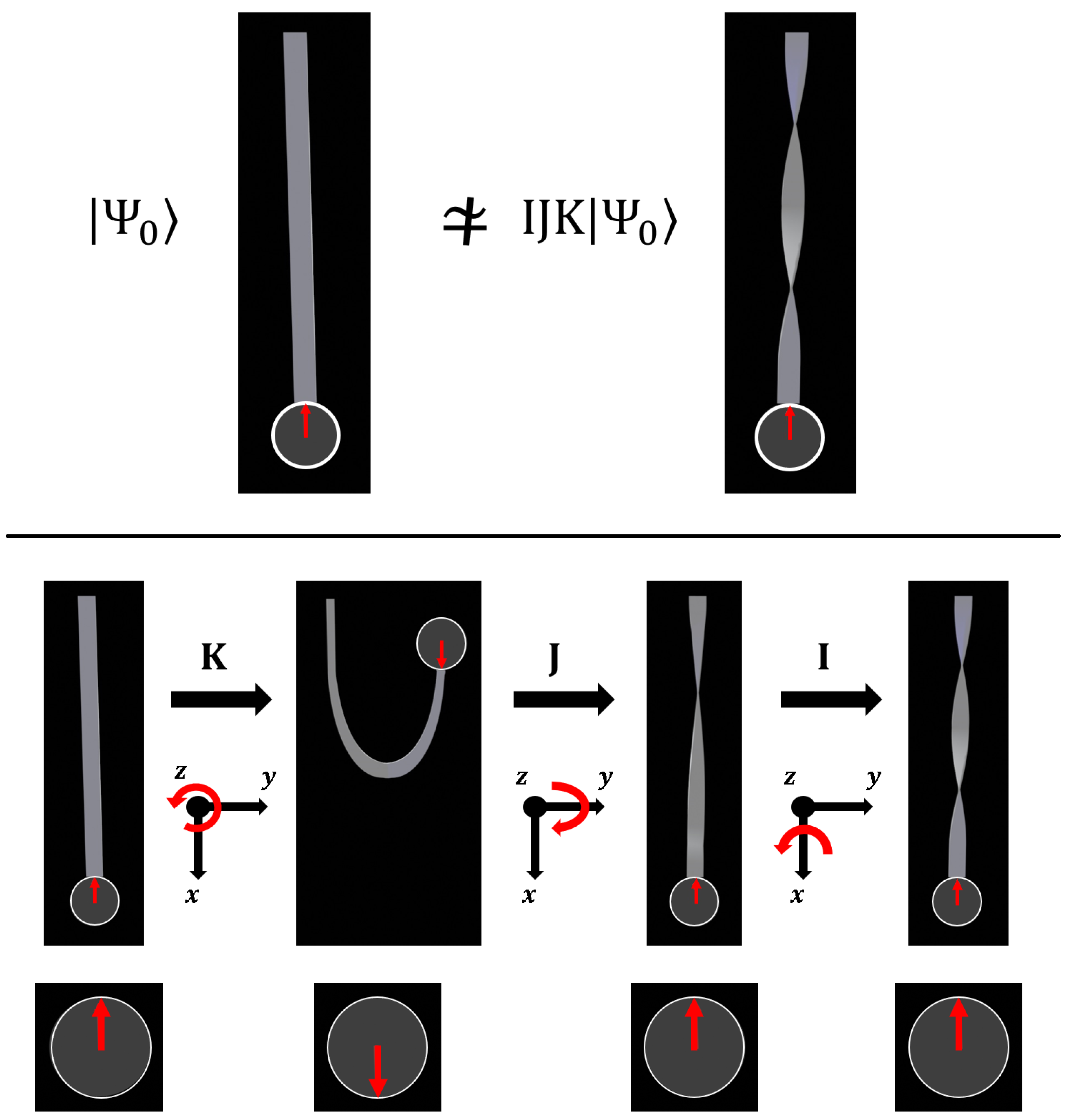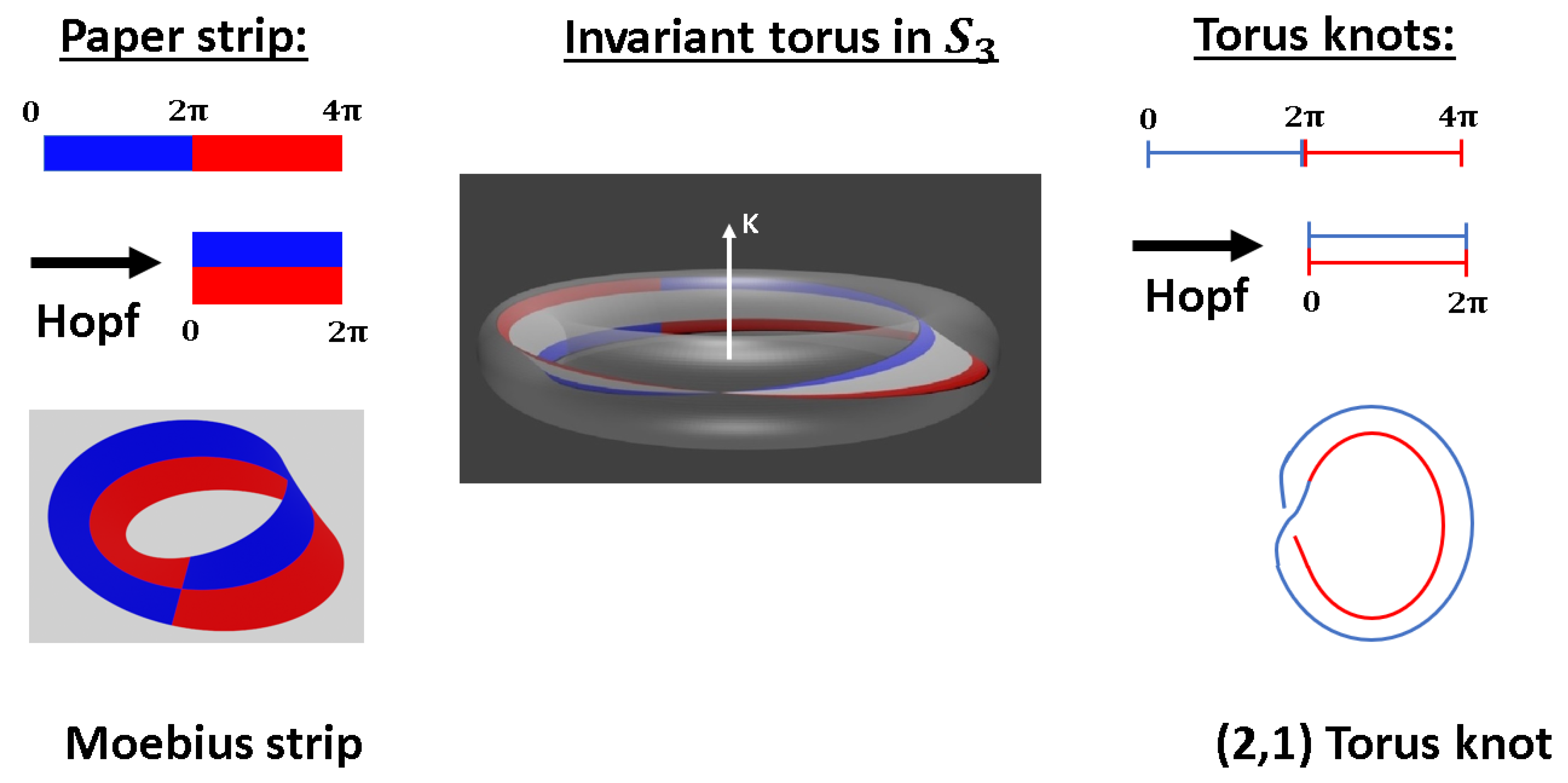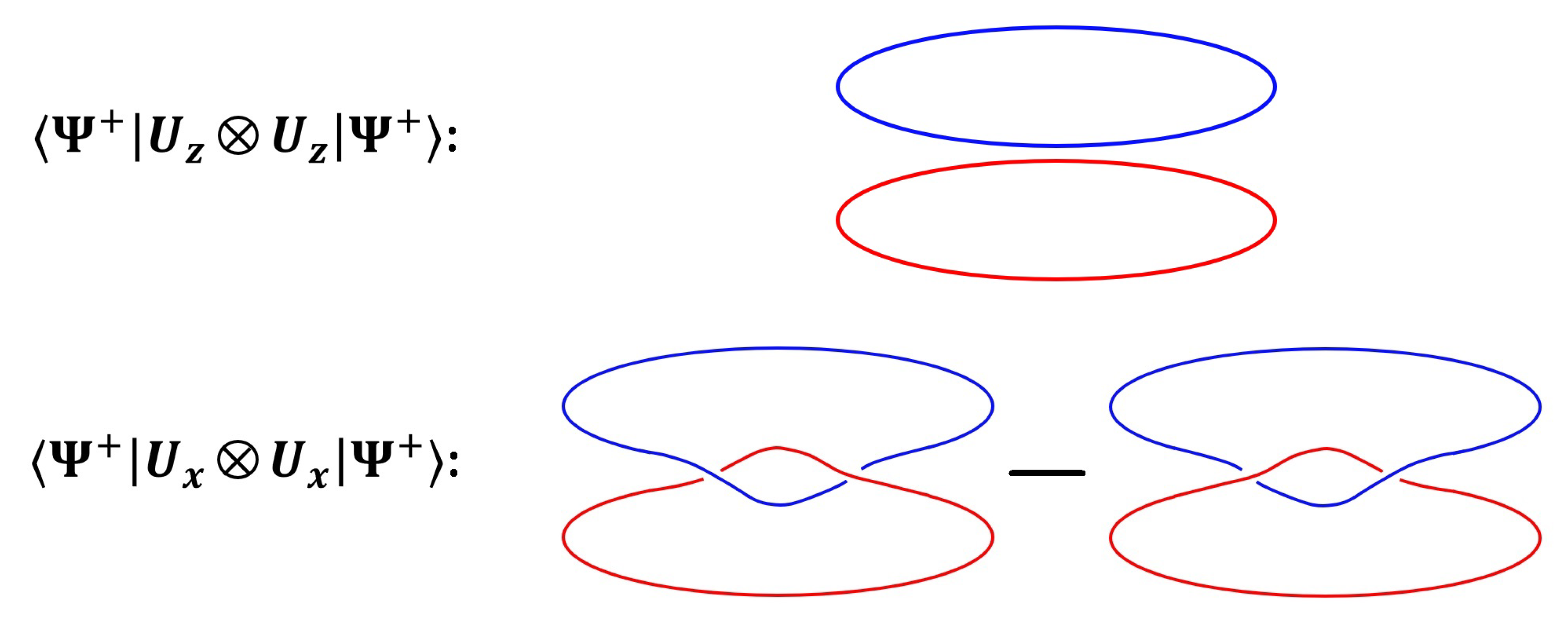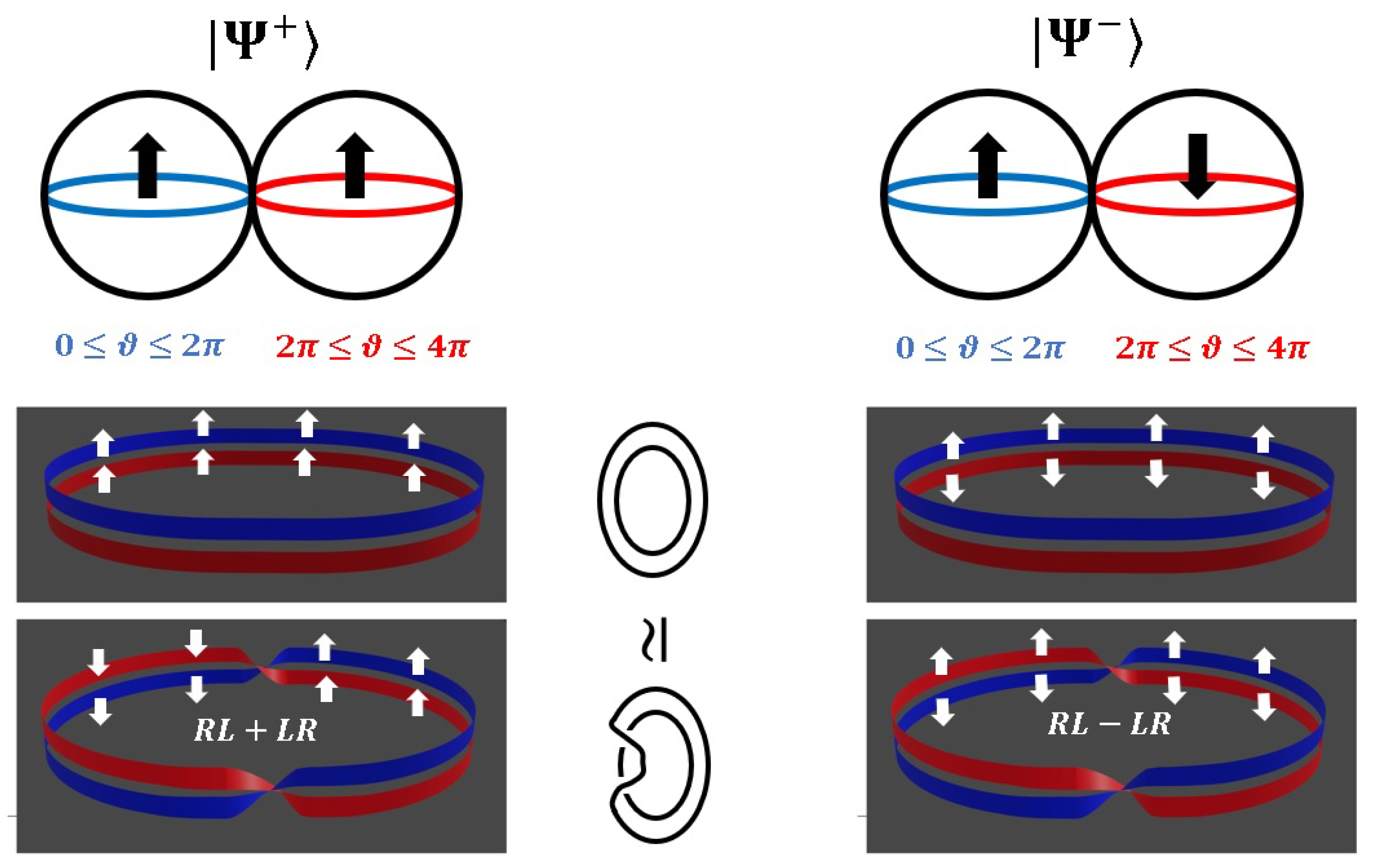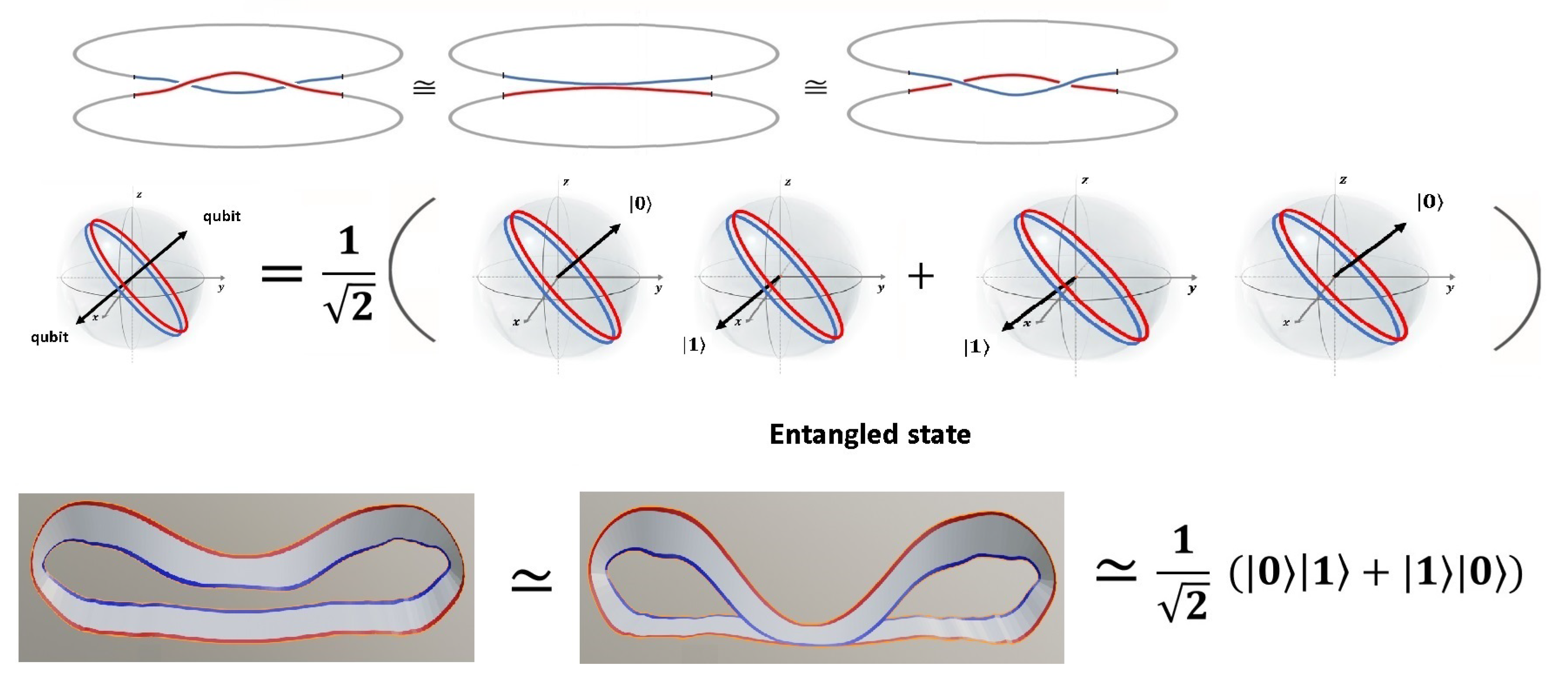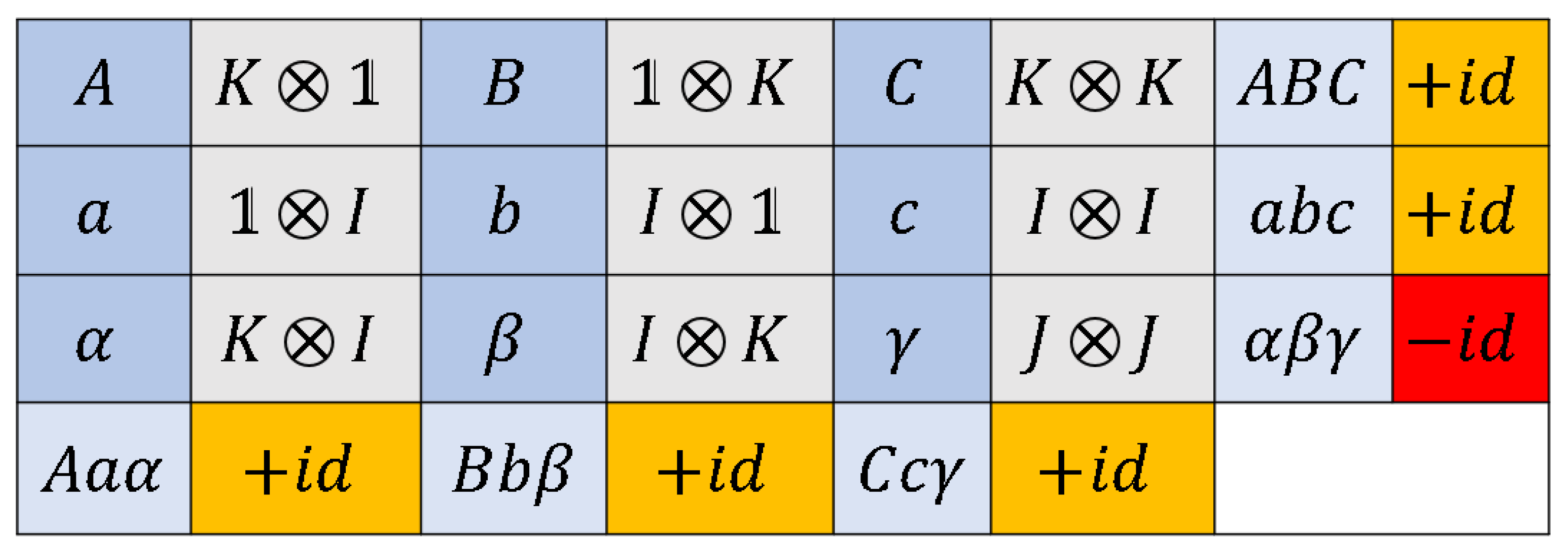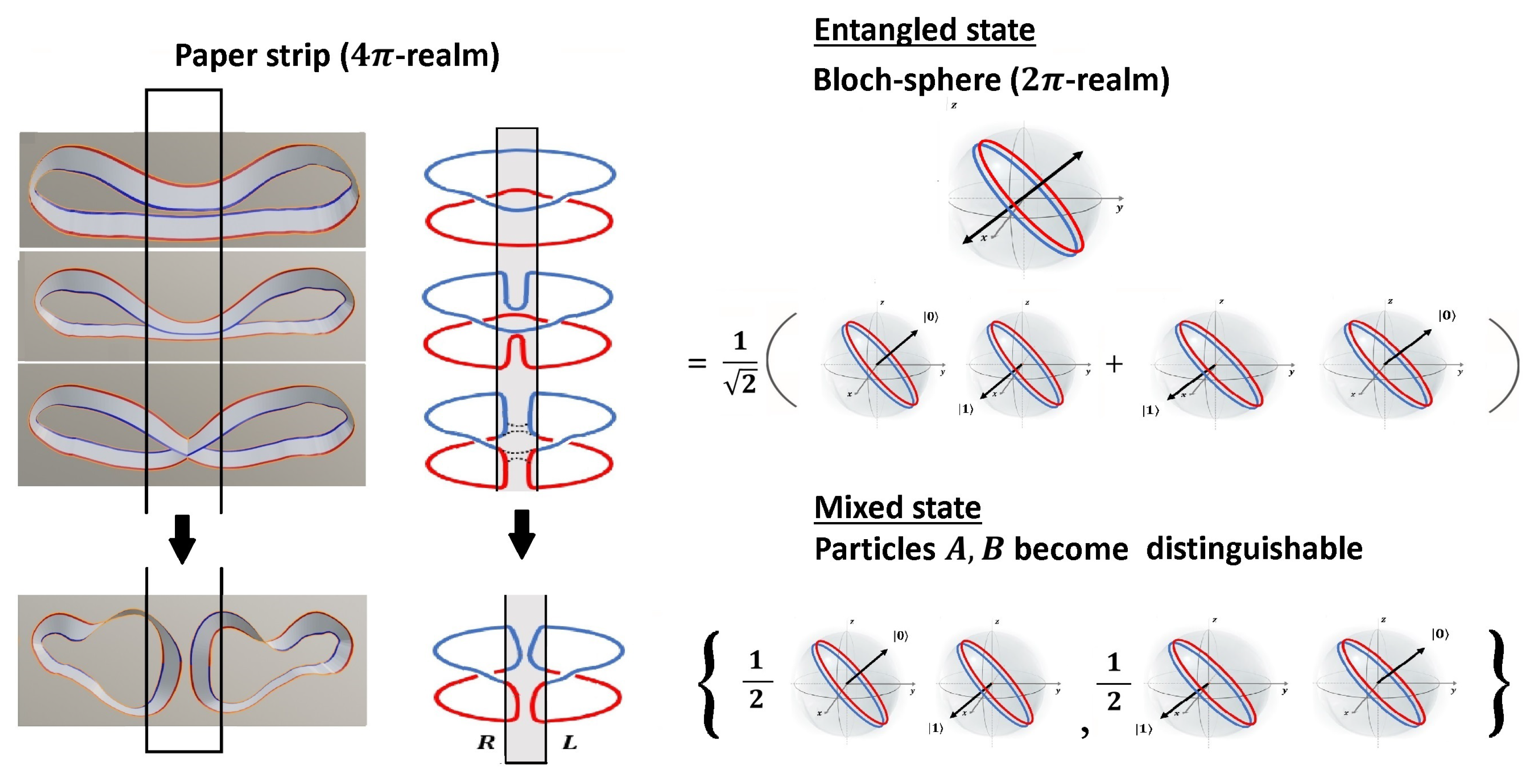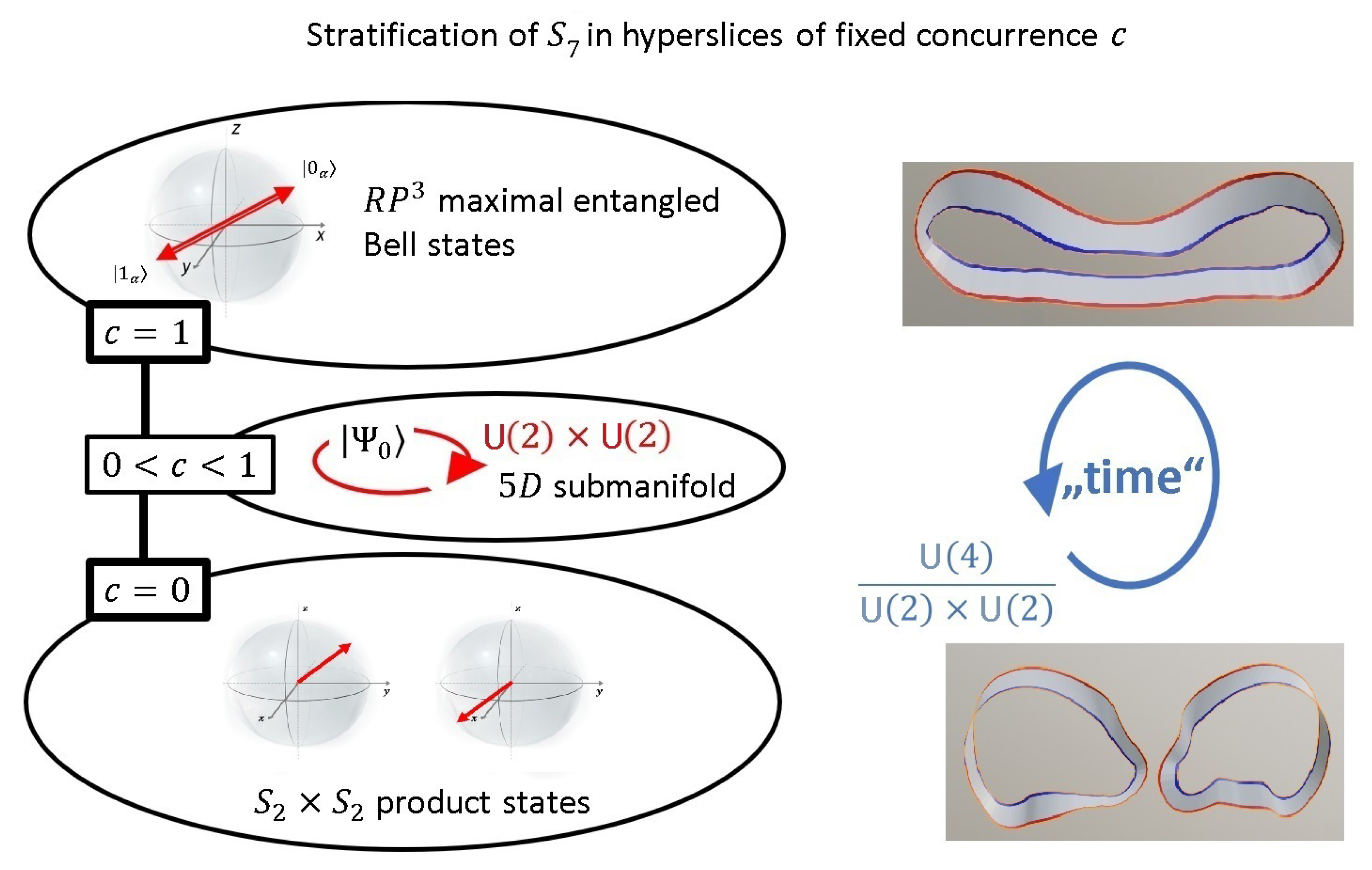1. Introduction
With the rapidly increasing importance of quantum communication and quantum computation, and in particular the increasing ability to manipulate systems of entangled qubits, the representation of qubits and operations with qubits is an important issue, in particular for writing codes for quantum computers [
1]. In this paper, we want to show that the encoding of operations using the Bloch-sphere representation is insufficient for several reasons. Most importantly, the difference between
and
-rotations cannot be encoded using the Bloch sphere representation. In this paper, we propose several generalizations of the Bloch sphere representation from a group theoretical and a knot theoretical perspective. In our argument, the symmetry of hyperspheres plays an important role—in particular, the Hopf-mapping
for single quibts, and its generalization
for entangled qubits.
In
Section 2, we start our discussion with an analysis of the group
and its covering group
. We introduce the Heegard-splitting of the Lie algebra
, and show that the Dirac belt construction is just a topological property of rotations in
, not necessarily related to quantum physics.
In
Section 3, we discuss dynamics of a qubit in a constant magnetic field from a group theoretical perspective. The Dirac belt naturally emerges in the description of amplitudes in
. We propose a minimal extension of the Bloch sphere representation to encode spin flip operations using a simple paper strip model in the
-realm [
2].
In
Section 4, we review the topological model of entanglement recently introduced in Reference [
3], and apply this model in
Section 5 to give a geometric interpretation of the Kochen-Specker theorem, which states that even for commuting observables, the eigenvalues of a given quantum state depend on the context. It turns out that the difference between
and
-rotations, which cannot be resolved in the usual Bloch-sphere representation, lies at the heart of
in quantum physics.
In
Section 6, we give a geometric argument
many-worlds theories. In particular, we show how the transition of an entangled state to a mixed state can naturally be modeled using the paper strip model of entanglement, leading naturally to an ensemble interpretation of amplitudes in quantum physics. Exactly like the ansatz of many-worlds theories, we only rely on symmetries and geometric properties of the unitary group.
In the summary and outlook, we discuss further possible applications of this topological approach to quantum physics, and their merits for physics education.
2. Geometry of Rotations in Real Space
In this section, we discuss simple rotations in real space
. Imagine the unit ball
defined by
. The coordinates
can be rotated to any other position
by acting with a
-rotation matrix
on the initial vector. As shown in
Figure 1, the unit vector
defines the rotation axis. After a rotation by an angle
with respect to this axis, the initial vector
is mapped to
Thus, the corresponding group element
in
is given by
On the level of the Lie algebra, we find the simple expression
where
are the antisymmetric generators of the Lie algebra
, given by
Obviously, the complete group can be characterized by three parameters—the direction of the rotation axis, indicated by the unit vector
with
, and the rotation angle
. The
-ball (with radius
) defined by
represents all possible group elements of
SO(3) on the level of the Lie algebra
. Note that the rotations
are identical rotations in
, therefore, antipodes of the
-ball are identified, see
Figure 1 and
Figure 2.
Consider the vector
in
. Then, the so-called
of this point is defined by
, where
g runs through all group elements
(that is, the full
-ball parametrizing the Lie algebra
). Obviously, this orbit is just the unit sphere
in real space
. Note that there is a subset
H of group elements leaving the initial vector invariant,
. In our case, this subset is given by the rotations
with
. It is a standard result of coset theory that the coset space
is isomorphic to the orbit, that is,
As shown in
Figure 1 and
Figure 2, the rotation by
around a given axis
is given by the straight line
with
. It is a well-known fact from group theory that this closed path is not equivalent to the Null homotopy. Indeed, as can be seen in
Figure 2, only after a second traversal, the path can be deformed to the Null Homotopy (that is, to the identity element in
at the origin of the
-ball). Paul Dirac proposed a fascinating method to illustrate the corresponding motion in real space
, that is, on the level of the group
SO(3) acting on, say, a unit ball (A simulation program for the Dirac belt trick can be found in
http://ariwatch.com/VS/Algorithms/Antitwister.htm). We attach this unit ball with elastic ropes (equivalently, with paper strips) to the boundary of a very large fixed outer sphere. The action of each group element
g on the unit ball is encoded in the twists of the ropes (the paper strips). As shown in
Figure 3, each rotation by
can be realized as an inner
in the paper strip attached to the rotated unit ball. Indeed, it can be shown that four inner twists can be undone, but not two. This exactly corresponds to the Null Homotopy shown in
Figure 2 with two traversals, that is, a
-rotation (You can convince yourself of this Null homotopy: Take a paper strip and rotate it four times. You may untwist it as shown in
https://vimeo.com/62228139).
The covering group of
is
, which reflects this
-symmetry. The
-algebra can be constructed using the quaternions
defined by
, and
(and cyclic). A general quaternion is given by
with
, which is geometrically just the hypersphere
. The geometry of the Lie algebra
of the group
can be described by the so-called Heegard splitting—the
-ball describing the
-Lie algebra is doubled, and the boundaries of both copies of the
-ball are identified with each other. The action of
can be illustrated using the Heegard splitting as shown in
Figure 2. In the covering group,
and
rotations can be distinguished as can also be seen in
Figure 2.
Quaternions have been introduced already in the 19th century by Hamilton–much the same as the Hamiltonian for energy in classical mechanics, the full meaning of these structures became only visible more than 50 years later, with the advent of quantum physics.
4. Paper Strip Model Model for a Pair of Entangled Qubits
Operations on two qubits are described by the unitary group
. Due to symmetry, all points in
are equivalent from a geometric point of view. It is the Hamiltonian which creates certain interpretation patterns within this geometry. For a given Hamiltonian, we can define a basis
of pairs of qubits. Pure states are described by the orbit of
, that is, the hypersphere
. While product states are only the small subsection
within
, all other states are (partially) entangled. The Bell-states represent maximally entangled states. We discuss the Bell states
While
is part of the spin triplet with
,
is the antisymmetric spin singlet state with
, which is basis invariant. As discussed in detail in Reference [
3], for any maximally entangled state, there exists a homotopic loop where the amplitude of
remains constant. For
, this is the rotation in
z-direction
Thus, the amplitude upon the
rotation remains constant, since
In contrast, the rotation in
x-direction leads to
Thus, the amplitude upon the
rotation is given by
. As discussed in the previous section, these amplitudes have infinitely many topologically equivalent representations. The paper strip model is one possible method to display these configurations, as shown in
Figure 8.
One merit of the paper strip model is the possibility to visualize topologically equivalent configurations which represent the same quantum state, or to be more precise, the same amplitude on a certain homotopic loop in Hilbert space. We discuss the homotopic loop with constant amplitude, because this provides a nice representation for entanglement—as discussed in detail in Reference [
3], this constant phase is topologically equivalent to a combination of one right twist
R and one left twist
L (see
Figure 9).
In other words, the quantum phase of the Bell state
is much less complicated as it seems—the states
and
merge to a constant phase, as their individual properties vanish. Thus, due to our choice to express the entangled state in the basis
, it is necessary to symmetrize and to write the complicated expression
as shown in
Figure 10.
As the singlet state
remains invariant under any rotation, the amplitude is constant on every homotopic loop, as expected for the state with a total spin of zero. Due to antisymmetry, the amplitude must vanish, and
is a pseudo-scalar. The exchange of both ’particles’ of the entangled state amounts to a rotation of
which can be done just by exchanging the role of both
-balls in the Heegard splitting. Indeed, as shown in
Figure 9, this leads to a global minus sign in case of
.
5. Kochen-Specker Theorem
As a first application of the knot theoretic extension the Bloch sphere representation of qubits, we discuss the Kochen-Specker theorem, which states that noncontextual hidden-variable theories are incompatible with predictions of quantum theory [
8]. We denote by
the eigenvalues related to the operators
A and
B. For a set of commuting observables, noncontextuality implies that the values of the observables are independent of the context, that is, independent of the other commuting observables. In particular, this means
. This assumption contradicts quantum physics, as was first shown by Kochen and Specker [
9]. While the first proof involved 117 vectors in four dimensions, Peres found a much simpler proof with nine observables in four dimensions in a system of two qubits [
10]. Later, Mermin [
8] introduced a set of observables known as Mermin’s square, and proposed a state-independent proof.
Following Peres and Mermin, we consider a combination of spin-flip operations
acting on a system of two qubits, as shown in
Figure 11. Indeed, in each row and each column, the observables mutually commute, and can be measured simultaneously. On the level of the spin-flip operators, the product of all rows and columns is given by
Note that this result crucially relies on the difference between the paths
and
, as shown in
Figure 5 on the level of the Lie algebra. The action on a given the quantum state by the corresponding group element in
SU(2) is shown in
Figure 6. Concerning the eigenvalues, the assumption of noncontextuality translates to the statement that the eigenvalues
of each spin-flip operator
(14) would be independent of the context. This implies that the product of eigenvalues of all rows and columns is independent of the combination of other observables involved, that is,
Obviously, the assumption of noncontextuality contradicts the result for the operators (24).
Several experiments revealed that the assumption of noncontextuality is in contradiction with observation. The Kochen-Specker-Theorem applies to all systems with three or more levels. While using so-called qutrits as a basis of experimental tests is possible, the use of four level systems seems to be the more widely applied method. A four-level system can easily be created by joint measurement of two qubits, regardless whether the two qubits are realised across different particles or as different degrees of freedom within a single quantum object. An illustrative example for a testing scheme using single photons is provided by Reference [
11], where a polarizing beam splitter is used to associate polarization (labelled superscript ’p’ with vectors
for horizontal and vertical polarization) and spatial path information (labelled superscript ’s’ with vectors
for transmission and reflection). By implementation of additional rotation and phase shift operations, arbitrary states can be generated within these two degrees of freedom.
As shown in
Figure 11, it is straightforward to show for an appropriate set of observables that the quantum mechanical prediction is at odds with the idea that each of the observables has a predefined value of +1 or −1 before measurement. In terms of expectation values obtained by measurements on statistic ensembles, the contradiction shown in Equations (24) and (26) can be brought into the form of an inequality which gives a criterion for experimental testing of contextuality [
12]. Under the assumption of noncontextuality, the measured expectation values can be expected to obey the following relation:
while quantum physics as a contextual theory predicts an outcome of
(see
Figure 11). The experimental task is therefore to find a suitable sequence of polarization and spatial path measurements, that is, of some combinations of the observables
and
that correspond to the nine operators in Equation (26).
It is important to note that even though the concrete choice of combinations of observables leading to a contradiction might vary with the details of the experimental implementation, Equation (26) is not dependent on any specific features of the quantum state it is applied to, hence it provides a powerful tool for testing contextuality in a very broad range of cases and applicable to entangled states as well as product states and even mixed states of four level systems [
13].
Since the first experimental tests for contextuality had been undertaken in the early 2000’s, different variations of inequalities have been tested in different experimental settings, using various physical substrates to implement three- or four-level systems. The range of implementations includes photonic states [
13,
14,
15,
16,
17], but also trapped ions [
18], free neutrons [
11] and molecular nucelar spins in the solid state [
19]. Some of these tests rely on inequalities that are explicitly restricted to specific classes of states [
11,
15,
16,
17], while some experimental settings also allow for testing of state-independent inequalities like Equation (26), providing experimental evidence of contextuality for a broad range of states [
13,
14,
18]. Even technological applications based on quantum contextuality have been discussed, for example the prospect for new methods in cryptography [
20] or models of quantum computing based on contextuality [
21].
In a nutshell, the Kochen-Specker theorem is an interesting variant to the fact that Hilbert space relies on a
-symmetry rather that a
-symmetry, which has already been shown long before with neutron interferometry of a simple single qubit in a magnetic field with a Hamiltonian similar to that discussed in
Section 3 [
22,
23]—here, it was shown for the first time experimentally that
-rotations differ from
-rotations. Thus, experiments give strong hints that the Hopf mapping between
-rotations and
-rotations is not just a mathematical curiosity of 19th century mathematics, but lies at the heart of the quantum nature of the observable universe.
Using this geometric point of view, noncontextuality can also be interpreted as follows: As shown in
Figure 5, the path of the quaternions
where in the Lie group
is just a straight line in the Heegard splitting. The sign ± just changes the direction of the motion along that path. Traversing the Dirac belt in reverse direction, the role of ’left’ and ’right’ twists is exchanged. But is there a way to distinguish left-moving from right-moving on a microspoic scale? In other words, is there a possibility to refer to a convention (a context) to assign ’left’ and ’right’? On the level of the relation between amplitudes and operators, as already seen in Equations (10) and (11), the definition of the sign is
due to symmetry. Only a relative sign, that is in the context of a given convention, can be defined.
On the level of the paper strip model, suppose you have a Möbius strip (equivalently, a Dirac belt in the -realm) at your disposal in a completely empty space, without any reference frame. There would be no way to assign a - or a - twist to this Moebius strip (the same is true, of course, for inner twists of the Dirac belt). Only by comparing this Moebius strip to a second one, it would be possible to decide whether both are tilted the same way, or in the opposite way. We conclude that as long as parity symmetry is not violated, a priori, there is no way to define ’ left’ and ’right’ in a unique manner.
6. Many-Worlds Theories of Quantum Physics
As second application of the knot theoretic extension of the Bloch sphere representation of qubits, we discuss many-worlds theories.
The original idea by Hugh Everett [
24] of a quantum physics without collapse of the wave function has been published under the title “Relative State Formulation of Quantum Mechanics” in 1957. Only later on, the compelling title “Many-worlds interpretation” was invented by DeWitt, making this approach more popular since the late 1960s [
25]. Albeit of no practical importance, up to today, the theory attracts much interest and plays an important role in the debate concerning the interpretation of quantum physics [
26]. Even after more than sixty years, there is no generally agreed set of postulates defining ’the Everett interpretation of quantum theory’, rather, there are ’many worlds’ in the interpretation of the many-worlds theory itself. In any case, the key idea of many-worlds theories is to consider unitary evolution as sufficient for the description of quantum physics and to avoid the necessity of a ’collapse’ of the wave function. For example, Carroll states that the many-worlds theory is the most straightforward approach to quantum mechanics [
27]: There is only the unitary group in quantum physics, with all possible wave functions at disposal. When something is realized in our world, the other possibilities contained in the wave function do not vanish. Instead, according to many-worlds theories, new worlds are created, that is, each possibility is a reality.
Interestingly, the paper strip model provides a simple argument
many-world theories, using the very same argument that only the symmetries of the unitary group are at disposal. Suppose that the interaction between two qubits causes entanglement. As
kind of interaction causes entanglement, this is a reasonable assumption to start with. Consider the entangled state
where in a given basis set
. The transition from the entangled state to a mixed state can easily be modeled as decoherence due to coupling to an environment of many qubits [
28]. The result is the transition of the entangled state to a mixed state. In any case, measurement leads to the transition into a state where the states
and
become distinguishable.
Many-worlds theory claims that once we measure the state
at A (Alice) and
at B (Bob), this implies that the ’other’ part of the wave function (
at A and
at B) is realized in a parallel universe. However, as shown in
Figure 12, in our description there is no ’other part’ of the wave function. Rather, the labels
are meaningless for an entangled state, as all individual properties of these particles disappear in the state
. In (28), the superposition of product states is needed to wash out the significance of the labels
, that is, to
the possibility of two ’parts’ of the wave function. Indeed, the entangled state can be represented just as a constant phase, which is topologically equivalent to the combination of two opposite twists [
3]. It is impossible to uniquely label A and B to these twists, as all homotopically equivalent variants coexist, as shown in
Figure 10. The same result comes from the fact that the choice of sign of the homotopy in (23) is arbitrary, thus without context. The definition of
R and
L twist is arbitrary. If for some reason, for example, due to decoherence, two distinguishable particles A, B emerge, it is obvious from
Figure 12 that only a
of qubits can be produced from the original entangled state. What is not yet determined is the labeling A, B for the pair
. In other words, the context where the states
emerge is not determined. But
the eigenvalue of
is defined
in the context A, then it must be
for
in B. Since this labeling is arbitrary at first, with probability
the labeling is either
or
. This is just the transition from the entangled state to the mixed state shown in
Figure 12, formally given by
Due to this transition, the off-diagonal terms of the density matrix vanish, indicating that particles
A and
B become distinguishable. Once the particles
become distinguishable from each other, there is no ’parallel universe’ opening with the inverse combination, simply because the association of the single pair of Dirac belts representing the states
shown in
Figure 12 to the qubits
can only be done once. We become aware of these two possibilities only if we observe many particles, since in the context of the first particle pair, we can only distinguish the sign difference. This leads to the ensemble interpretation of the wave function by only using symmetries and geometric properties of the unitary group.
More generally, we can reformulate this argument based on a
view of quantum physics [
29]: In the unitary group
, there is complete symmetry between all parameters describing the group. At first, all points on the sphere
are equally meaningless. The Hamiltonian (see
Section 3 for an example) defines what ’time’ is within
. For example, as shown in
Figure 4, the direction of the magnetic field defines the parameter ’time’ in
, and in turn, the interpretation of the parameters of the quantum states as time-like and space-like, as defined in (13).
In the case of
relevant for the entanglement of two qubits, the same holds true. At first, all points on the hypersphere
are equally meaningless. In an arbitrary basis, we may introduce the coordinates
where for a general pure state, equivalent to
. Within
, infinitely many possibilities to define two qubits in the six-dimensional subspace
(equivalently,
) coexist. We may call this
transformation ’local’, acting on each separate qubit alone. In terms of dimensions, within the seven dimensions from
, one more ’non-local’ dimension is left. As shown in Reference [
30], this dimension can be defined as concurrence
c, given by
For
, we obtain the subspace
of two independent qubits, while
defines the subspace
of maximally entangled Bell-states as shown in
Figure 13. The structure of the interaction is defined by the Hamiltonian
. Here,
are two quaternions as defined in Equation (2). It is this Hamiltonian which defines what is ’time’ within
. As interaction leads to entanglement, indeed, the concurrence
c is intimately related to time development in case of interaction.
The time development with the unitary matrix
leads to an oscillation between the states of separate qubits with
, and maximally entangled states with
[
28]. The ’local’ unitary operations
can then be associated with operations in ’space’, for example, as angle of a polarizing beam splitter in quantum optics, or as direction of the inhomogeneous magnetic field for spin measurement in a Stern-Gerlach apparatus. Indeed, these directions can be defined and manipulated separately at detector A and B.
Geometrically, the time development from
to
as shown in
Figure 13 describes the transition from the space of Bell-states (
) to the product space
of two qubits (for a review of the stratification see
Appendix B). This is just the transition shown in the paper strip model in
Figure 12 in relation to the complete space
of pure two-qubit states.
As for , the qubits A and B loose their individual properties, this naturally leads to the problem of undefined labels under this transition, implying in the association of the parameters of to the detectors A and B in space - but not to parallel universes, simply because within , for purely geometric reasons, there is no more ’copy’ of at disposal for the reverse labeling, as already anticipated using the paper strip model.
Thus, many-worlds would imply some mechanism for the extension of the unitary group from to upon transition from to , since the existence of both possibilities for the separate pairs and lead to the necessity for a doubling of to . In principle, this cannot be excluded. However, our argument shows that within the usual unitary time development defined by the Schrödinger equation, such a mechanism is not given. Thus many-worlds theory would need to define a mechanism which leads to such an extension of the unitary group.

